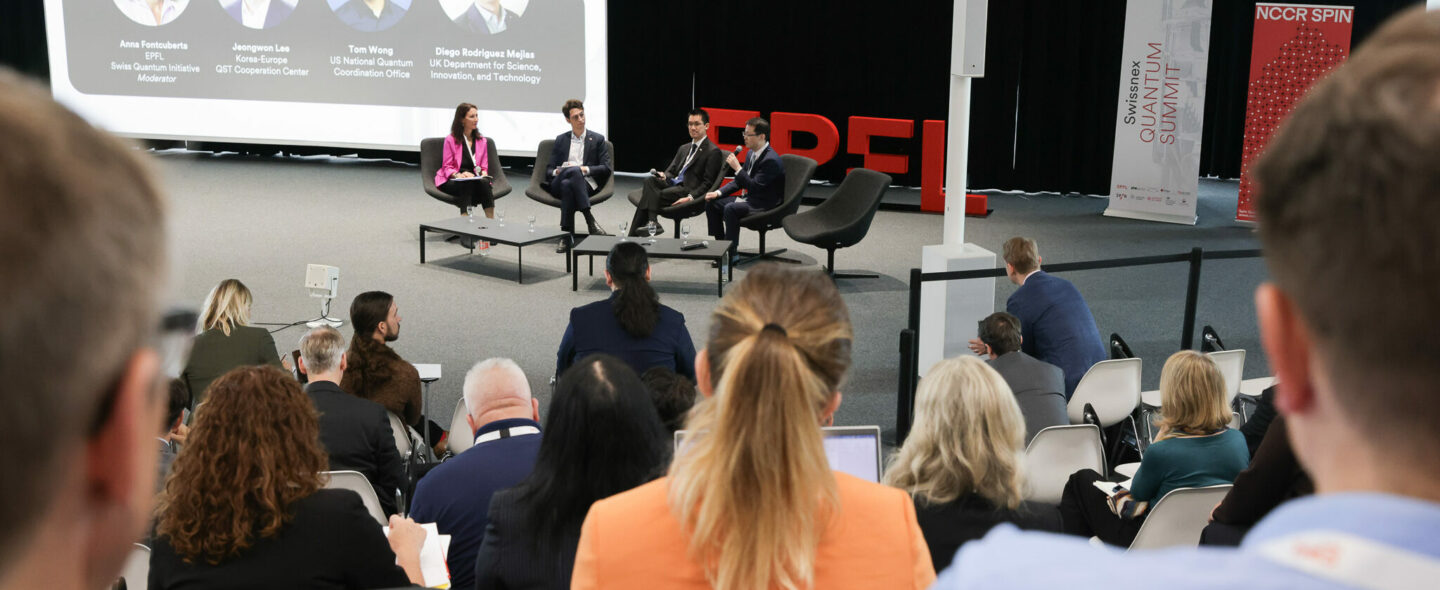
October 30. 2023 | Boston & New York
Over 100 participants from ten countries convened on October 14, 2023, for the Swissnex Quantum Summit, held at the EPFL Rolex Learning Center in Lausanne as part of Swissnex’s Project Quantum. The summit brought together representatives from academia, research centers, industry, accelerators, and government in order to discuss best practices and common challenges in building quantum ecosystems. Here are 25 key insights from the conference:
Building National Quantum Initiatives
- Quantum funding has been active since the 1990s in many countries but has only become organized through national initiatives in the last few years. We must be patient to see the results of these programs.
- Governments can play useful roles by funding both basic and applied research, de-risking investments, creating certifications and standards, and also becoming early adopters of new technologies.
- Government-led post-quantum cryptography, spearheaded by the US National Institute of Standards and Technology (NIST), will set the new de facto global standards and is seen as the best short-term solution for encryption that is safe from quantum algorithms.
- Governments that are pumping huge sums into quantum may be better served by spreading that money out over longer-term timelines.
- Governments are keen to collaborate internationally with like-minded countries, but they can do much more to make public funding internationally available and easier to obtain across borders.
Fostering Science and Technology Breakthroughs
- The first applications of quantum computing will likely be for scientists. We must ask what scientific problems can be solved by the output of quantum machines. This will drive the types of devices we build.
- Scientists should also converse with companies and other potential end users, in order to understand what “pull factors” can direct the science towards useful ends.
- Ecosystems are needed to bridge the many technology readiness levels between basic science and commercial applications.
- Talent development remains key to accelerating the pace of science. Many programs are focused on increasing the diversity of talent, especially along gender lines.
- Collaboration needs more than just money; it requires relating to different mindsets and agendas.
- The downsides of not collaborating internationally are far worse than any challenges of working together.
Accelerating Commercialization and Impact
- From process design kits to software, enabling technologies, and cybersecurity, the quantum industry is vast and extends far beyond building just quantum computing hardware.
- Lots of companies making cutting-edge products for quantum devices should find intermediate markets (ex. LIDAR, AI), as the quantum market isn’t big enough yet to support all of them.
- Only a few VCs are concentrated on quantum, but selected larger VCs are taking an increasing interest in the sector.
- Development is not linear, as seen in AI. After a long “AI winter,” the field is now burning hot amid generational advances. The same could hold true for quantum.
- Trends toward technological sovereignty may create fragmented markets, rather than a global quantum market.
Preparing for the Quantum Era
- From private foundations and challenge grants to large multinational research programs, there are many actors funding development for use cases. Quantum applications in the life sciences and biotech are a particularly active early pursuit of relevant use cases.
- Scientific cases do not equal business cases; most use cases now are largely experimental and hypothetical. The quantum field needs not just scientific talent but also business talent to assess and take proper risks and to find promising market applications.
- Talent development takes time! It can take years to set up a new degree program, and then two more years to produce master students and 5+ years for PhDs. We should see the fruits of this labor in 2025 and beyond.
- Getting students interested in quantum as early as possible (even primary school!) can diversify the talent pool.
- Building a pipeline of talent must go beyond educating physicists; students from related disciplines must also learn quantum principles and relevant technologies.
Where Do We Go From Here?
- The next five years will be key to demonstrating a useful quantum computing advantage.
- Our main enemies are excessive hype and the lack of patience that it can engender. We should underpromise and overdeliver whenever possible.
- From a certain perspective, a “quantum winter” (a downturn in funding) may not be the worst case; it could cull some of the lower-performing companies and allow the field to concentrate its energies.
- In principle, the field is developing well: many countries have excellent funding, new education programs are emerging, and companies are taking an interest. Much of our collective task is to not lose this momentum.
The Swissnex Quantum Summit was an initiative of Swissnex in Boston and New York organized in collaboration with the rest of the global Swissnex network, with generous support from host institution EPFL and its Center for Quantum Science and Engineering, as well as ETH Zurich, the Paul Scherrer Institut, the Swiss Federal Laboratories for Materials Science and Technology (Empa), NCCR SPIN, the University of Basel, the Swiss Academy of Sciences (SCNAT), the University of Geneva, the UK Science and Innovation Network, and the South Korean Ministry of Science and ICT.
To find out more about the Swiss quantum ecosystem, see our new factsheet, Switzerland: a Hub for Quantum.
To view the photos from the Swissnex Quantum Summit, click here: